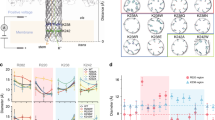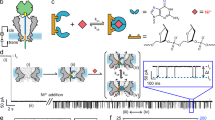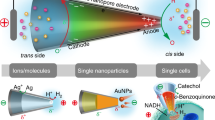Abstract
Stochastic sensing is an emerging analytical technique that relies upon single-molecule detection. Transmembrane pores, into which binding sites for analytes have been placed by genetic engineering, have been developed as stochastic sensing elements1,2,3. Reversible occupation of an engineered binding site modulates the ionic current passing through a pore in a transmembrane potential and thereby provides both the concentration of an analyte and, through a characteristic signature, its identity1,2,3. Here, we show that the concentrations of two or more divalent metal ions in solution can be determined simultaneously with a single sensor element. Further, the sensor element can be permanently calibrated without a detailed understanding of the kinetics of interaction of the metal ions with the engineered pore.
This is a preview of subscription content, access via your institution
Access options
Subscribe to this journal
Receive 12 print issues and online access
$209.00 per year
only $17.42 per issue
Buy this article
- Purchase on Springer Link
- Instant access to full article PDF
Prices may be subject to local taxes which are calculated during checkout




Similar content being viewed by others
References
Braha, O. et al. Designed protein pores as components for biosensors. Chem. Biol. 4, 497–505 (1997).
Gu, L.-Q., Braha, O., Conlan, S., Cheley, S. & Bayley, H. Stochastic sensing of organic analytes by a pore-forming protein containing a molecular adapter. Nature 398, 686–690 (1999).
Bayley, H., Braha, O. & Gu, L.-Q. Stochastic sensing with protein pores. Adv. Mater. 12, 139–142 (2000).
Cornell, B.A. et al. A biosensor that uses ion-channel switches. Nature 387, 580–583 (1997).
Motesharei, K. & Ghadiri, M.R. Diffusion-limited size-selective ion sensing based on SAM-supported peptide nanotubes. J. Am. Chem. Soc. 119, 11306–11312 (1997).
Gouaux, E. α-Hemolysin from Staphylococcus aureus: an archetype of β-barrel, channel-forming toxins. J. Struct. Biol. 121, 110–122 (1998).
Olson, R., Nariya, H., Yokota, K., Kamio, Y. & Gouaux, E. Crystal structure of staphylococcal LukF delineates conformational changes accompanying formation of a transmembrane channel. Nat. Struct. Biol. 6, 134–140 (1999).
Pédelacq, J.-D. et al. The structure of Staphylococcus aureus leukocidin component (LukF-PV) reveals the fold of the water-soluble species of a family of transmembrane pore-forming toxins. Structure 7, 277–288 (1999).
Song, L. et al. Structure of staphylococcal α-hemolysin, a heptameric transmembrane pore. Science 274, 1859–1865 (1996).
Qin, F. A., Auerbach, A. & Sachs, F. The QuB suite: www.qub.buffalo.edu.
Proakis, J.G. & Manolakis, D.G. Digital signal processing: principles, algorithms and applications. Prentice Hall, Englewood Cliffs, NJ; 1995).
Kasianowicz, J.J., Burden, D.L., Han, L.C., Cheley, S. & Bayley, H. Genetically engineered metal ion binding sites on the outside of a channel's transmembrane β barrel. Biophys. J. 76, 837–845 (1999).
Young, S.H. & Poo, M. Spontaneous release of transmitter from growth cones of embryonic cells. Nature 305, 634–637 (1983).
Hume, R.I., Role, L.W. & Fischbach, G.D. Acetylcholine release from growth cones detected with patches of acetylcholine receptor-rich membranes. Nature 305, 632–634 (1983).
Kramer, R.H. Patch cramming: monitoring intracellular messengers in intact cells with membrane patches containing detector ion channels. Neuron 4, 335–341 (1990).
Hanke, W. & Schlue, W.-R. Planar lipid bilayers. (Academic Press, London; 1993).
Vivaudou, M., Arnoult, C. & Villaz, M. Skeletal muscle ATP-sensitive K+ channels recorded from sarcolemmal blebs of split fibers: ATP-inhibition is reduced by magnesium and ADP. J. Membrane Biol. 122, 165–175 (1991).
Acknowledgements
This work was supported by the Defense Research Projects Agency, the Department of Energy and the Office of Naval Research.
Author information
Authors and Affiliations
Corresponding author
Supplementary Information
Rights and permissions
About this article
Cite this article
Braha, O., Gu, LQ., Zhou, L. et al. Simultaneous stochastic sensing of divalent metal ions. Nat Biotechnol 18, 1005–1007 (2000). https://doi.org/10.1038/79275
Received:
Accepted:
Issue Date:
DOI: https://doi.org/10.1038/79275
This article is cited by
-
High-resolution discrimination of homologous and isomeric proteinogenic amino acids in nanopore sensors with ultrashort single-walled carbon nanotubes
Nature Communications (2023)
-
Real-time sensing of neurotransmitters by functionalized nanopores embedded in a single live cell
Molecular Biomedicine (2021)
-
Programmable nano-reactors for stochastic sensing
Nature Communications (2021)
-
Giant single molecule chemistry events observed from a tetrachloroaurate(III) embedded Mycobacterium smegmatis porin A nanopore
Nature Communications (2019)
-
Challenging Nanopores with Analyte Scope and Environment
Journal of Analysis and Testing (2019)



